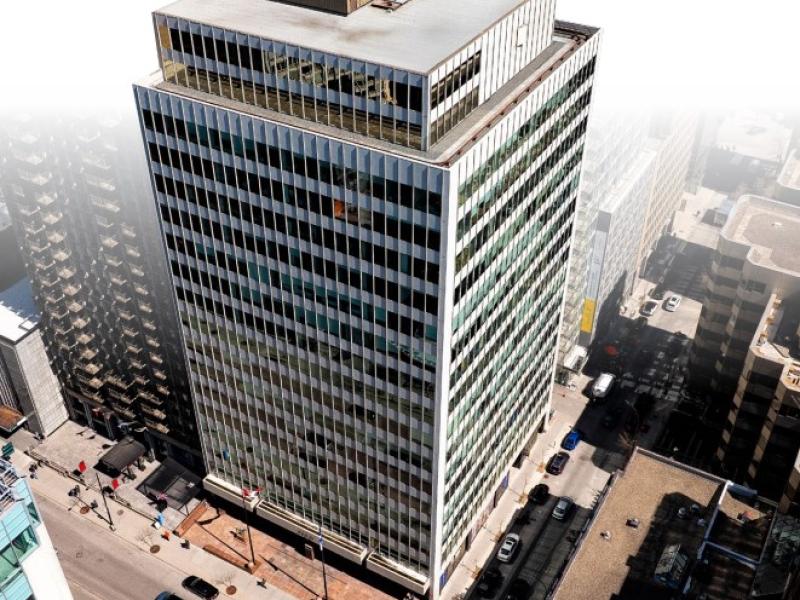
Greystone Village is being built in Ottawa by Regional Group and its housing arm, EQ Homes. The darker structures at lower right are part of Saint Paul University, separate from the development. (Rendering courtesy EQ)
Infill construction is common in major Canadian cities, so in that sense Ottawa’s Greystone Village isn’t unique. What’s different about this development at the eastern edge of the downtown is that its 1,000 residents won’t be living in high-rise towers.
Instead, Greystone Village is a combination of freehold single-family dwellings and townhomes, low- to mid-rise apartment and condo buildings, along with some office/commercial space. It’s being constructed by Ottawa-based Regional Group and its housing arm EQ Homes.
“We knew the regulatory limits of this site when we bought it,” said Josh Kardish, vice-president of EQ Homes, in an interview with RENX. “For the most part, we are staying within those limits. We have asked for some small exemptions, but nothing like the kind you might read about in other parts of Ottawa.”
Kardish, a manager in the land development team at Regional Group before moving over to EQ, has considerable experience with these kinds of developments. He says much thought went into the decision to not build high.
Infill development in “small community”
“There’s a lot of rational reasons for that. One of the big ones is that this is a small community,” he explained. “I don’t think that there would really be much of a market-based response to a 20-storey tower. I’m not sure how a 200-unit tower would be received in the marketplace, so the scale is proportionate to the community.”
Greystone Village is a 26-acre urban infill development tucked in to a century-old neighbourhood between the Rideau River, the Rideau Canal and Highway 417. The Saint Paul University grounds border portions of the development, and Ottawa University is just a kilometre or two away.
It was purchased in 2014 with conceptual approval for 1,000 dwelling units, plus commercial and community spaces. As it currently sits, the project is on pace for about 1,000 dwellings, 70,000 square feet of commercial, a public park and possibly a community centre.
It’s also the first LEED ND-certified community in the City of Ottawa.
To date, Greystone Village has closed on 85 homes and expects to close on 50 more by June 2020.
Condo construction underway
Occupation of the first nine-storey condo tower is expected to begin in November. EQ is about to break ground on a second nine-storey tower right next to it in the coming weeks. Together, they’ll contain 200 condos.
By 2020 EQ hopes to also break ground on two purpose-built rental buildings, six- and nine-storey towers fronting Main Street, with 240 units between them. Also on the list are renovations to the Edifice Deschâtelets Scholasticate Monastery, a heritage building and former home to the Fathers of the Oblate Order, which sits at the centre of the community.
“We’ve played with a lot of different models, but we haven’t settled on one that we’ve decided to run with completely,” said Kardish. EQ is considering purpose-built rentals, condominiums, or unique types of office space. “We’re still kind of tinkering.
“The reality is that the decision-making around that building will only solidify when we know where the municipality stands on being an actual development partner in that block.”
Former monastery a heritage building
The building is protected under the Ontario Heritage Act, so preserving its history is part of EQ’s plan. Kardish calls it a “unique situation” and said EQ is hoping to partner with the City of Ottawa to incorporate a community centre.
Potential community spaces aren’t the only amenities for future residents. Several key pieces of infrastructure enabled the development to pre-qualify for the LEED ND certification — despite being only about a third complete.
EQ Homes built public roads through the community which will be turned over to the city. Each has sidewalks on both sides, and residences are designed to hide garages rather than having them be the main focus of the front of the homes. The idea is for vehicles to not dominate the Greystone Village streetscape, which has the added benefit of making it easier to find places to plant trees.
“Given the soils that we have in Ottawa, it’s a bit of a challenge to put a home that is proud to the front of the street, a narrow street, and a sidewalk entry. I know it doesn’t sound like that much of a complex arrangement, but because there are so many utilities under the road, it does get kind of challenging,” said Kardish.
EQ brought in different soil so it could plant trees which eventually will form a canopy over the street.
Sustainability built in to project
In terms of sustainability, EQ has upgraded natural habitat for animals along the Ottawa River adjacent to the site, built a bus loop through the community to put public transit within easy reach of residents, and the north end is within walking distance of Ottawa’s LRT.
Instead of bringing in truckloads of fill from outside the city, builders used fill from the nearby LRT excavations. This cut down on greenhouse gases, repurposed fill which needed to be dealt with, and also replaced some existing contaminated soil.
At its inception, the development was the largest brownfield project in Ottawa, a designation which has since been usurped by the Zibi development, but Greystone remains the city’s largest completed brownfield cleanup.
The design and sustainability efforts are paying off.
“If you drive by and take a look at it, you might think that it looks like a condominium and some houses in the middle of an old community,” Kardish said. “But when you pay attention to the details, you see the thought that has gone into how roads are designed, how you move within the community, and how we prioritize pedestrians and cycling over cars within the community.
“We still managed to make it look like the surrounding area and we work with the local community to build something that everybody’s excited and proud of.”







